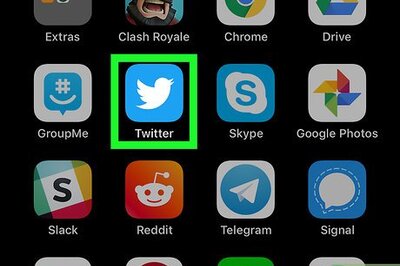
views
Join Amazon Prime.
Amazon Prime members get extra discounts at Whole Foods. As an Amazon partner, Whole Foods rewards Prime members with seasonal and everyday discounts. So, what can you get while grocery shopping if you’re a Prime member? Take a look at the list below: Unlimited grocery delivery for $9.99 a month Tuesday sales on premade meals and products (rotisserie chicken, salad, etc.) Friday deals on premade meals (sushi, pizza, etc.) 10% off sale items 5% cashback when you shop at Whole Foods or Amazon.com with a Prime Visa Free store pickup and delivery Free Amazon pickups and returns Pay with your hand using Amazon One
Download the Whole Foods app.
Coupons and exclusive deals can be found in the Whole Foods app. Like most grocery stores, Whole Foods rewards customers in their rewards program. Download the app and sign up to view and save coupons and weekly deals. Along with getting access to weekly deals and sales, you can also access your Prime discount, make orders, and create a shopping list on the app.
Shop Prime Day deals.
Whole Foods has special deals for Prime members in July and October. Like Amazon’s digital Prime Day, Whole Foods has exclusive sales and deals for Prime members. Use your Amazon Prime account or Whole Foods app to access savings on Prime Day. Here are some examples of deals from years past: 35% off ice cream Buy-on-get-one LaCroix 30% off boneless chicken breasts
Buy 365 Everyday Value products.
Whole Foods’ generic brand is typically cheaper. Like most grocery stores, Whole Foods has a generic brand that competes against name-brand items. 365 Everyday Value products are usually less expensive and taste similar to name-brand products, so they can help keep your grocery budget in check without sacrificing quality. For example, 365 Everyday Value Organic Unsweetened Vanilla Almondmilk is $3.49, while Califia Farms Unsweetened Vanilla Almondmilk is $4.99. Keep in mind that pricing can vary. Generic products aren’t always cheaper than name-brand items.
Shop sales Wednesday through Tuesday.
Whole Foods updates their sales every Wednesday. Sales last until the following Tuesday, and most product discounts are from 20% to 30% off. So, if there’s an item on sale that you really want, aim to shop Wednesday to ensure it’s still in stock during the sale. Find out what items are on sale each week with Whole Foods’ weekly sales flyer.
Use coupons and saving apps.
Paper and digital coupons can save you lots of money. Search for Whole Foods’ coupons in your local paper or online with websites, like Coupons.com and RetailMeNot. Then, write your grocery list around your coupons to create a weekly meal plan on a budget. Similarly, you can earn cashback using rebate apps, like Ibotta and Checkout 51. Simply upload a picture of your receipt and watch the cash flow in!
Shop with a Whole Foods reusable bag.
In some locations, Whole Foods gives a $0.10 credit for using reusable bags. Whole Foods puts the environment first, and that includes their bag policy! Some stores encourage customers to use their reusable bags and earn $0.10 towards their total. All it requires is a one-time purchase of a Whole Foods reusable bag. Keep in mind that this isn’t available for every store, so ask your store’s manager if something like this is offered. Be aware that some cities and states require grocery stores to pay for plastic bags, making using a reusable bag much more cost-effective.
Avoid premade items.
Meals and dishes that are already made can be more expensive. Opt to buy individual ingredients rather than a premade meal at Whole Foods. While these meals are great in a pinch, they’re not ideal for your budget. Try cooking more of your meals yourself and freezing leftovers.
Buy bulk items.
Buying just what you need can help you save money. Utilize Whole Foods’ extensive bulk aisle(s) to get amounts of everyday staples you know you’ll use. Items are priced by weight so you can be more efficient with your budget. For instance, say you love fresh nut butter but can never finish a jar before it spoils. At Whole Foods, you can make freshly churned nut butter in any size you like. As another example, prepackaged black beans typically cost $4.79 a pound, while bulk bin black beans cost $2.29 (a $2.50 savings).
Opt for frozen veggies over fresh.
Frozen food lasts longer and is less expensive. While it may seem counterintuitive, frozen vegetables are actually fresher than fresh vegetables. This is because frozen foods are packaged at peak freshness. A frozen bag of broccoli may seem more expensive than a fresh head of broccoli, but you’re saving money in the long haul because frozen broccoli won’t spoil like fresh broccoli. This hack can be super helpful if you have trouble eating veggies before they go bad—less food waste means less money wasted!
Purchase meat substitutes.
Plant-based proteins are usually cheaper in the long haul. Even if you’re not on a plant-based or vegetarian diet, meat substitutes can generally be cheaper than real meat. So, if you’re trying to save a few bucks, opt for an Impossible Burger, jackfruit “pulled pork,” block of tofu, or go meatless.
Skip the sauces at the buffet.
Sauces can add extra weight and dollar signs. Whole Foods is known for their fresh and delicious buffet options. However, it can be super easy to turn a cheap meal into something pricey if you have a heavy hand. Buffet boxes are priced based on weight, so avoid add-ons like sauces to keep your meal as cheap as possible. If you’re craving a sauce, consider buying a prepackaged one. While it may be pricer now, the investment will save you money.
Ask for samples.
Testing a product before you buy it can help you save money. Is there an item you’ve always wanted to try? Maybe it’s an expensive chocolate or fancy chicken dish. Either way, warranting a more indulgent purchase can be hard if you don’t know if you’ll like the product. This is where free samples come in! Many Whole Foods stores offer samples of trendy or new products. These can be found by a display or an employee-run stand.



















Comments
0 comment